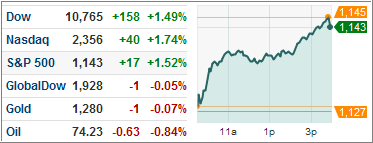
The markets slipped slightly during the early trading hours yesterday with all eyes feasted on the outcome of the Fed meeting on interest rates.
Leaving rates unchanged was pretty much a given, but the accompanying statement was the big unknown. After the release, the markets shot up, as the chart (courtesy of marketwatch.com) above shows, then dropped just as sharply, rebounded and faded into the close.
The Fed made it clear that it worries about the slowness of the recovery. They further cited a “substantial resource slack” with high unemployment and modest income gains, but reiterated that they were “prepared to provide additional accommodation if needed to support the economic recovery.”
Some economists expect the Fed to make that next move at its November meeting, which would provide them with more additional data. The Fed further conceded that economic recovery continues to slow, although there are signs of stabilization.
The immediate beneficiaries of this announcement were gold, due to uncertainty, and bonds, due to lower interest rates. The dollar fell along with oil.
In the end, it was a statement with no earth shattering news and certainly not encouraging when it comes to economic prospects in general.
It makes me wonder if Monday’s rally was a blow-off day, to be followed by a trend reversal. Only time will tell, but I believe that the September rally has been way overdone and the markets, as they sometimes tend to do, have gotten way ahead of underlying realities.







